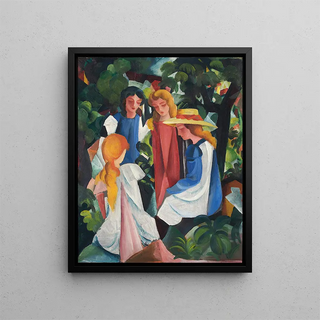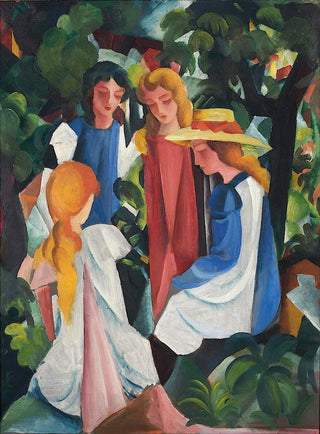Painting Four Girls - August Macke | Art print


View from behind

Frame (optional)
"Four Girls" by August Macke is a masterpiece that transcends time through its vibrancy and emotional depth. Painted in 1912, this canvas embodies the spirit of the Expressionist movement, where color and form blend to evoke intense feelings. The delicately arranged female figures seem to capture a fleeting moment of complicity and carefree joy. The interaction between the characters and the colorful environment creates a lively atmosphere, inviting the viewer to immerse themselves in a universe that is both joyful and melancholic. This work is much more than a simple representation; it is a celebration of life, human relationships, and ephemeral beauty.
Style and uniqueness of the work
The originality of "Four Girls" lies in the bold use of color and stylized forms. Macke, a master of color, applies vivid hues that intertwine harmoniously, creating a dynamic composition. The silhouettes of the young women, though simplified, are imbued with a sensitivity that makes them profoundly human. The background, with its abstract patterns and bright nuances, enhances the impression of movement and lightness. This innovative approach, where emotion takes precedence over realistic depiction, makes this piece a key work of the early 20th century. Every brushstroke seems to vibrate with energy, and the artwork manages to evoke universal feelings of joy, friendship, and freedom.
The artist and his influence
August Macke, born in 1887 in Meschede, is one of the emblematic figures of German Expressionism. Influenced by the artistic currents of his time, notably Fauvism and Cubism, he develops a unique style that combines color and abstraction. Macke is also known for his travels, particularly to Tunisia, which enrich his palette and artistic vision. His ability to capture the essence of the moment and translate complex emotions through simple forms left a mark on his contemporaries and continues to inspire many artists today. By incorporating elements of everyday life and scenes from nature, he manages to create a dialogue between art and reality,

Matte finish

View from behind

Frame (optional)
"Four Girls" by August Macke is a masterpiece that transcends time through its vibrancy and emotional depth. Painted in 1912, this canvas embodies the spirit of the Expressionist movement, where color and form blend to evoke intense feelings. The delicately arranged female figures seem to capture a fleeting moment of complicity and carefree joy. The interaction between the characters and the colorful environment creates a lively atmosphere, inviting the viewer to immerse themselves in a universe that is both joyful and melancholic. This work is much more than a simple representation; it is a celebration of life, human relationships, and ephemeral beauty.
Style and uniqueness of the work
The originality of "Four Girls" lies in the bold use of color and stylized forms. Macke, a master of color, applies vivid hues that intertwine harmoniously, creating a dynamic composition. The silhouettes of the young women, though simplified, are imbued with a sensitivity that makes them profoundly human. The background, with its abstract patterns and bright nuances, enhances the impression of movement and lightness. This innovative approach, where emotion takes precedence over realistic depiction, makes this piece a key work of the early 20th century. Every brushstroke seems to vibrate with energy, and the artwork manages to evoke universal feelings of joy, friendship, and freedom.
The artist and his influence
August Macke, born in 1887 in Meschede, is one of the emblematic figures of German Expressionism. Influenced by the artistic currents of his time, notably Fauvism and Cubism, he develops a unique style that combines color and abstraction. Macke is also known for his travels, particularly to Tunisia, which enrich his palette and artistic vision. His ability to capture the essence of the moment and translate complex emotions through simple forms left a mark on his contemporaries and continues to inspire many artists today. By incorporating elements of everyday life and scenes from nature, he manages to create a dialogue between art and reality,
12,34 €






